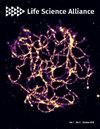Human CRB1 and CRB2 form homo- and heteromeric protein complexes in the retina.
IF 3.3
2区 生物学
Q1 BIOLOGY
引用次数: 0
Abstract
Crumbs homolog 1 (CRB1) is one of the key genes linked to retinitis pigmentosa and Leber congenital amaurosis, which are characterized by a high clinical heterogeneity. The Crumbs family member CRB2 has a similar protein structure to CRB1, and in zebrafish, Crb2 has been shown to interact through the extracellular domain. Here, we show that CRB1 and CRB2 co-localize in the human retina and human iPSC-derived retinal organoids. In retina-specific pull-downs, CRB1 was enriched in CRB2 samples, supporting a CRB1-CRB2 interaction. Furthermore, novel interactors of the crumbs complex were identified, representing a retina-derived protein interaction network. Using co-immunoprecipitation, we further demonstrate that human canonical CRB1 interacts with CRB1 and CRB2, but not with CRB3, which lacks an extracellular domain. Next, we explored how missense mutations in the extracellular domain affect CRB1-CRB2 interactions. We observed no or a mild loss of CRB1-CRB2 interaction, when interrogating various CRB1 or CRB2 missense mutants in vitro. Taken together, our results show a stable interaction of human canonical CRB2 and CRB1 in the retina.人类 CRB1 和 CRB2 在视网膜中形成同源和异源蛋白复合物。
Crumbs同源物1(CRB1)是与视网膜色素变性和Leber先天性无视力症相关的关键基因之一,这两种疾病的临床特征是高度异质性。Crumbs家族成员CRB2的蛋白质结构与CRB1相似,在斑马鱼中,Crb2被证明通过胞外结构域相互作用。在这里,我们发现 CRB1 和 CRB2 共同定位在人类视网膜和源自人类 iPSC 的视网膜器官组织中。在视网膜特异性拉取试验中,CRB1富集在CRB2样本中,支持CRB1-CRB2相互作用。此外,还发现了屑复合体的新型相互作用者,代表了视网膜衍生蛋白相互作用网络。通过共免疫沉淀,我们进一步证明了人类典型 CRB1 与 CRB1 和 CRB2 有相互作用,但与缺乏胞外结构域的 CRB3 没有相互作用。接下来,我们探讨了细胞外结构域的错义突变如何影响 CRB1-CRB2 的相互作用。在体外检测各种 CRB1 或 CRB2 错义突变体时,我们观察到 CRB1-CRB2 相互作用没有或轻微丧失。综上所述,我们的研究结果表明,人类典型 CRB2 和 CRB1 在视网膜中存在稳定的相互作用。
本文章由计算机程序翻译,如有差异,请以英文原文为准。
求助全文
约1分钟内获得全文
求助全文
来源期刊

Life Science Alliance
Agricultural and Biological Sciences-Plant Science
CiteScore
5.80
自引率
2.30%
发文量
241
审稿时长
10 weeks
期刊介绍:
Life Science Alliance is a global, open-access, editorially independent, and peer-reviewed journal launched by an alliance of EMBO Press, Rockefeller University Press, and Cold Spring Harbor Laboratory Press. Life Science Alliance is committed to rapid, fair, and transparent publication of valuable research from across all areas in the life sciences.
 求助内容:
求助内容: 应助结果提醒方式:
应助结果提醒方式:


